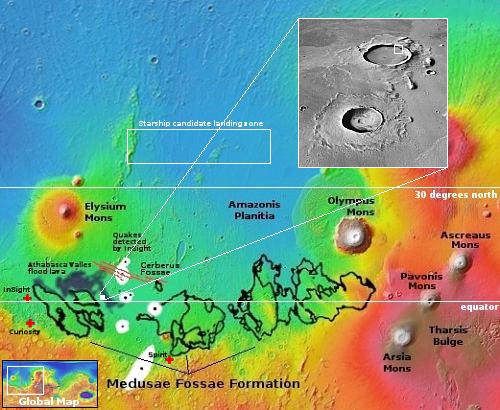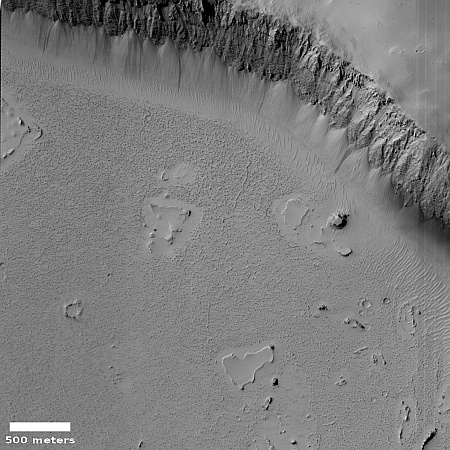Lava-filled Martian crater
Cool image time! The picture to the right, rotated, cropped, reduced, and sharpened to post here, was taken on July 10, 2023 by the high resolution camera on Mars Reconnaissance Orbiter (MRO). It shows the northeast corner of an unnamed 7-mile-wide crater, located near the equator in the dry Martian tropics.
The MRO science team labels this “crater and lava fill”, suggesting that the crater interior is filled with lava material. The nature of that crater floor reinforces this conclusion, as it is relatively smooth and does not have rough aspects of glacial material found in craters in the mid-latitudes. Instead, it looks like a frozen lake of lava that has the peaks of mostly buried features poking up at various spots.
What makes this crater interesting however are the gullies on the northern interior rim. Gullies on Mars are normally thought to be associated with some water-frost-ice process, probably seasonal, where the thaw-freeze cycle causes small collapses and avalanches. Yet, this crater is almost at the equator, in a very dry region where no evidence of near-surface ice is found. Gullies here suggest the hypothesis for explaining the gullies on Mars have not quite solved the mystery.

The white dot on the overview map to the right marks the location, with the white rectangle in the inset indicating the area covered by the picture. This crater sits on the edge of the Athabasca Valles flood lava event, what some researchers believe to be the most recent major volcanic event on Mars, having occurred about 600 million years ago. That event covered an area about the size of Great Britain in only a matter of weeks.
The splash aprons around this crater, as well as the one directly to the southwest, suggest that their impact occurred when that lava was still soft, timing that seems unlikely since the lava event was so very short-lived. The splash aprons could also be formed if there was a lot of near surface ice at this spot, but once again, this location is near the equator, and orbital data shows no evidence such ice anywhere near Athabasca.
It could be that the impacts simply melted the frozen lava at this location, producing the splash aprons. Yet if so, why do the few other craters nearby lack such aprons? The general lack of craters in this region tells us that all existing craters here occurred after the Athabasca flood lava event, making them relatively young. That some have splash aprons and others do not however is difficult to explain.
Thus we have another geological mystery on Mars, solvable only when humans can walk the surface and study in detail.
On Christmas Eve 1968 three Americans became the first humans to visit another world. What they did to celebrate was unexpected and profound, and will be remembered throughout all human history. Genesis: the Story of Apollo 8, Robert Zimmerman's classic history of humanity's first journey to another world, tells that story, and it is now available as both an ebook and an audiobook, both with a foreword by Valerie Anders and a new introduction by Robert Zimmerman.
The ebook is available everywhere for $5.99 (before discount) at amazon, or direct from my ebook publisher, ebookit. If you buy it from ebookit you don't support the big tech companies and the author gets a bigger cut much sooner.
The audiobook is also available at all these vendors, and is also free with a 30-day trial membership to Audible.
"Not simply about one mission, [Genesis] is also the history of America's quest for the moon... Zimmerman has done a masterful job of tying disparate events together into a solid account of one of America's greatest human triumphs."--San Antonio Express-News
Cool image time! The picture to the right, rotated, cropped, reduced, and sharpened to post here, was taken on July 10, 2023 by the high resolution camera on Mars Reconnaissance Orbiter (MRO). It shows the northeast corner of an unnamed 7-mile-wide crater, located near the equator in the dry Martian tropics.
The MRO science team labels this “crater and lava fill”, suggesting that the crater interior is filled with lava material. The nature of that crater floor reinforces this conclusion, as it is relatively smooth and does not have rough aspects of glacial material found in craters in the mid-latitudes. Instead, it looks like a frozen lake of lava that has the peaks of mostly buried features poking up at various spots.
What makes this crater interesting however are the gullies on the northern interior rim. Gullies on Mars are normally thought to be associated with some water-frost-ice process, probably seasonal, where the thaw-freeze cycle causes small collapses and avalanches. Yet, this crater is almost at the equator, in a very dry region where no evidence of near-surface ice is found. Gullies here suggest the hypothesis for explaining the gullies on Mars have not quite solved the mystery.

The white dot on the overview map to the right marks the location, with the white rectangle in the inset indicating the area covered by the picture. This crater sits on the edge of the Athabasca Valles flood lava event, what some researchers believe to be the most recent major volcanic event on Mars, having occurred about 600 million years ago. That event covered an area about the size of Great Britain in only a matter of weeks.
The splash aprons around this crater, as well as the one directly to the southwest, suggest that their impact occurred when that lava was still soft, timing that seems unlikely since the lava event was so very short-lived. The splash aprons could also be formed if there was a lot of near surface ice at this spot, but once again, this location is near the equator, and orbital data shows no evidence such ice anywhere near Athabasca.
It could be that the impacts simply melted the frozen lava at this location, producing the splash aprons. Yet if so, why do the few other craters nearby lack such aprons? The general lack of craters in this region tells us that all existing craters here occurred after the Athabasca flood lava event, making them relatively young. That some have splash aprons and others do not however is difficult to explain.
Thus we have another geological mystery on Mars, solvable only when humans can walk the surface and study in detail.
On Christmas Eve 1968 three Americans became the first humans to visit another world. What they did to celebrate was unexpected and profound, and will be remembered throughout all human history. Genesis: the Story of Apollo 8, Robert Zimmerman's classic history of humanity's first journey to another world, tells that story, and it is now available as both an ebook and an audiobook, both with a foreword by Valerie Anders and a new introduction by Robert Zimmerman.
The ebook is available everywhere for $5.99 (before discount) at amazon, or direct from my ebook publisher, ebookit. If you buy it from ebookit you don't support the big tech companies and the author gets a bigger cut much sooner.
The audiobook is also available at all these vendors, and is also free with a 30-day trial membership to Audible.
"Not simply about one mission, [Genesis] is also the history of America's quest for the moon... Zimmerman has done a masterful job of tying disparate events together into a solid account of one of America's greatest human triumphs."--San Antonio Express-News



I like a good mystery.
The best guess I have is the magma is close to the surface and the impact penetrated the crust and splashed the molten center, filling the crater from inside and creating the larger lava event?
Otherwise, your explanation of mars being wet, going through a glacial period in the recent past is probably the better idea.
If our solar system past through supernova remains in the local fluff, with gases that blocked the sun light covering Mars and all the moons (like Europa) with ice, including the ice ages of earth. The extra water mass may have moved the earth to a higher orbit where it wasn’t so hot like during the dinosaurs.
There are many things wrong with my explanation including the likelihood that Mars was still active at the time of impact.
The gullies along the crater rim we’re not eroded by water, then deposited that material below the gullies… but rather the wind blowing the sand up the face, then the sand trickled down like water eroding and depositing below each gullie. (that’s what the visual evidence suggests)
Slope streaks, some fresh, are above the crater walls. A different mystery.